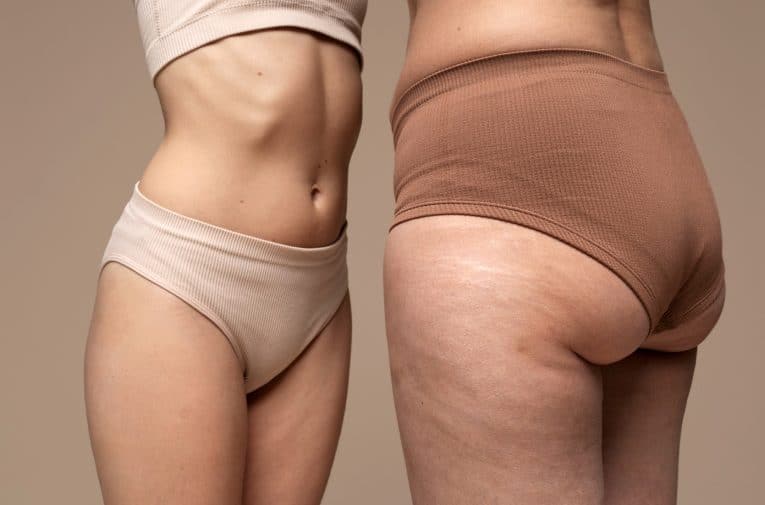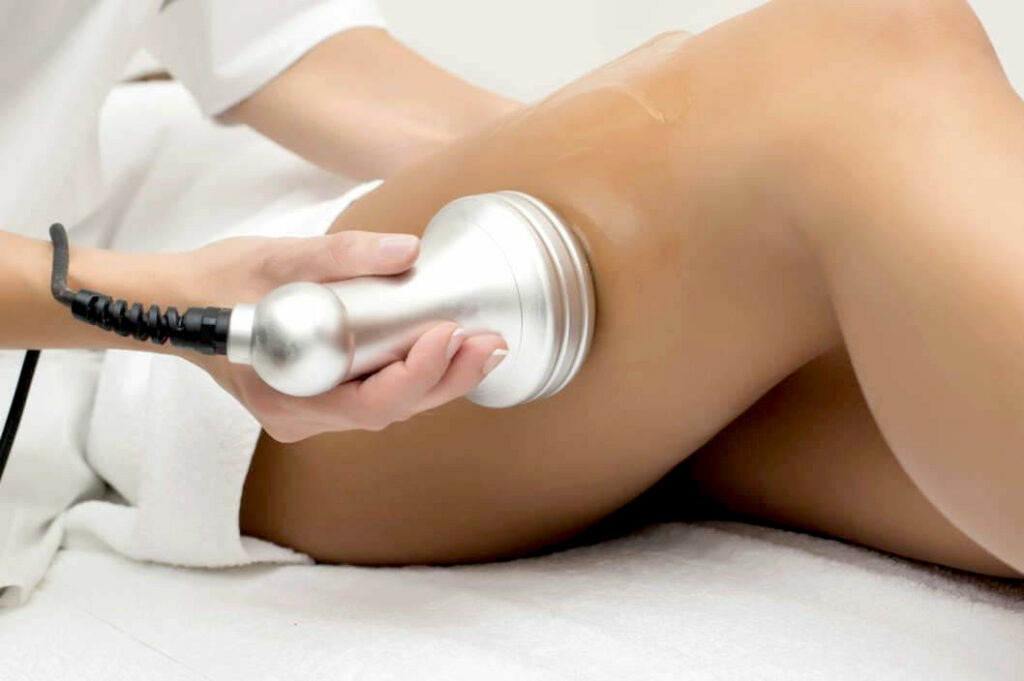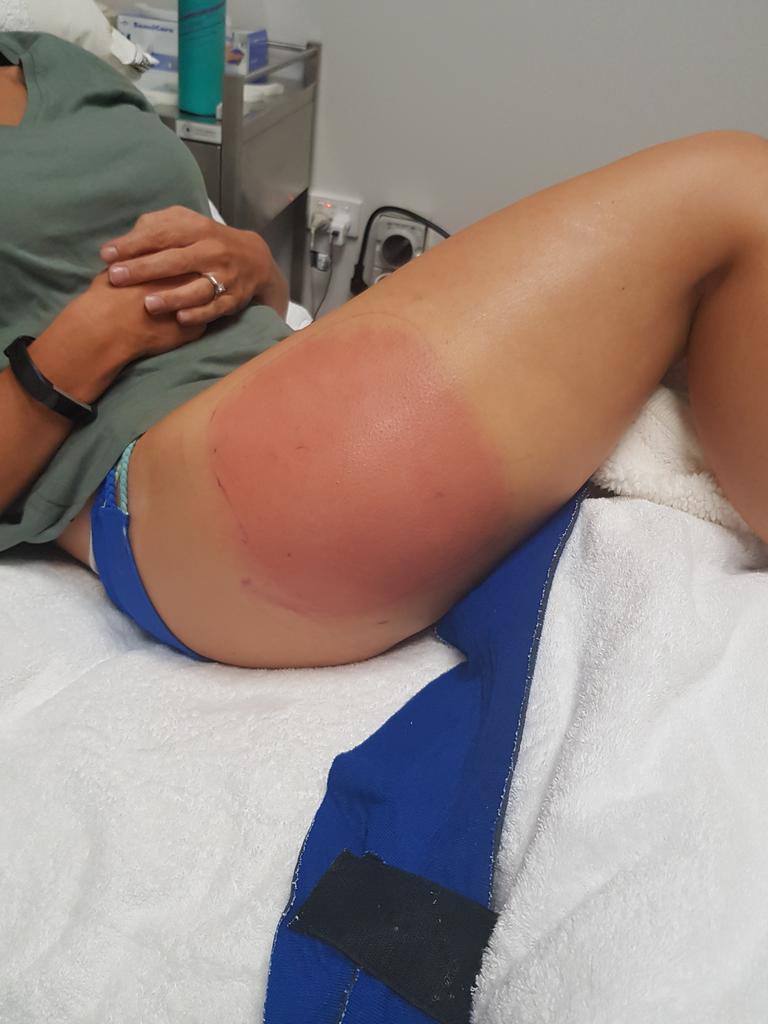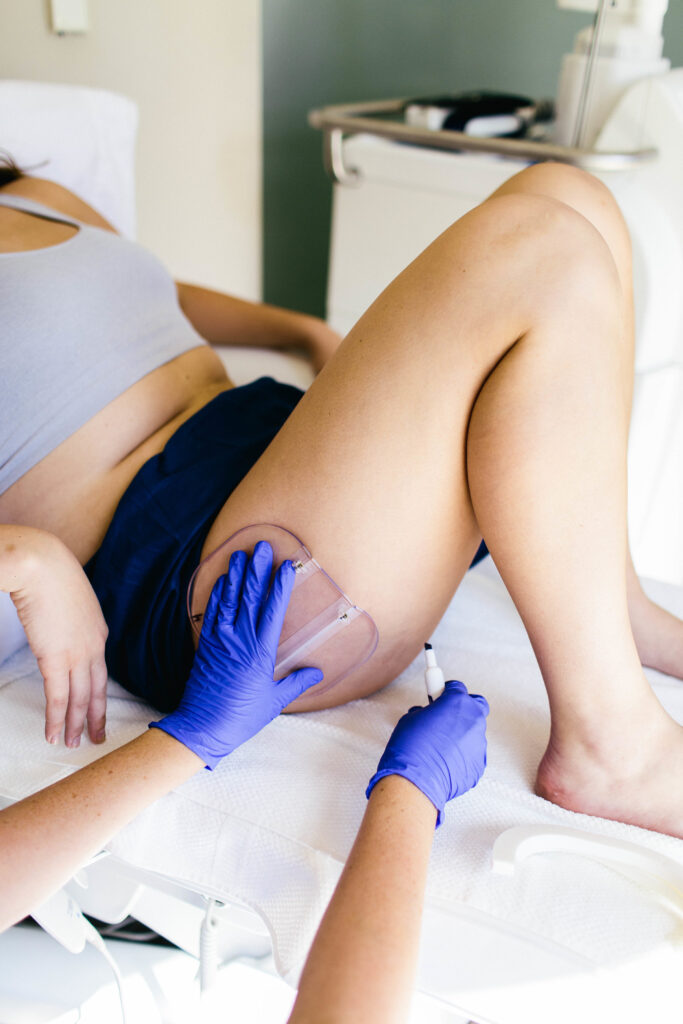
Saddlebag fat is a common term used to describe the accumulation of fat on the upper thighs and the outer buttocks. This phenomenon, primarily observed in women, often leads to body dissatisfaction and insecurity. In this article, you’ll find answers to common questions: What exactly is saddlebag fat? What are its causes? And what are the solutions to address it?
Saddlebag fat is characterized by the accumulation of subcutaneous adipose tissue on the outer buttocks and upper thighs. This distribution of fat is influenced by various factors, including hormonal, genetic, and lifestyle-related ones. Estrogens play a key role in this body fat distribution, which explains why saddlebag fat is more common in women. It often appears during adolescence and creates a silhouette that resembles the shape of riding breeches on the hips.
Although it is completely natural and harmless to health, some women may wish to reduce it for aesthetic reasons.
The options for treating saddlebag fat vary and may include non-invasive methods such as cryolipolysis, radiofrequency, and lipocavitation, or more invasive approaches like surgical liposuction. These treatments aim to reduce adipocytes (fat cells) in the targeted area, thus improving the body’s contour in this region of the buttocks and hips
Several factors contribute to the development of saddlebags in women. Among them are :
-Genetic factor: Some women are naturally predisposed to accumulate localized fat in this area of the body
-Hormonal imbalances: Hormonal variations, such as those occurring during puberty, pregnancy, or menopause, can promote the appearance of saddlebags.
– Diet and lifestyle: A diet high in fats and sugars, as well as a sedentary lifestyle without exercise, can accentuate the phenomenon.

Targeted muscle exercises to tone the muscles of the thighs and hips can help reduce saddlebags.
Cryolipolysis and cavitation combined with radiofrequency are recent technologies that reduce fat deposits without surgery to help lose saddlebags. These techniques are based on the application of intense cold or heat with radiofrequency and ultrasound to destroy fat cells.
For more radical results, liposuction remains an option. This surgical procedure aims to remove localized fat directly. This technique, being surgical, will not be developed in this article
Also known as “CoolSculpting,” it is a technique that uses cold to destroy fat deposits. During the treatment, adipocytes are exposed to a negative temperature, which causes their gradual destruction. These cells are then naturally eliminated by the body through the lymphatic system. The results are visible after about 2 to 3 months and are not associated with weight loss but rather localized slimming.
Saddlebags, a fat deposit in the hips and upper thighs, is an ideal area for cryolipolysis. It specifically targets these fat cells without damaging surrounding tissues.
The technique is non-invasive and does not require anesthesia, with minimal recovery time.

An applicator is positioned on the targeted part on each side of the body. You are comfortably installed with the 2 applicators in place. You can relax during the 60-minute session.
The adipocytes are brought to a negative temperature, inducing their apoptosis, i.e., their programmed cell death. You may feel a cold sensation at the beginning, which quickly subsides. This will be done without pain or discomfort.
The first effects can be observed as early as three weeks after the treatment. They are generally visible after two months. In some cases, several sessions may be necessary to eliminate saddlebags. It is effective in reducing fat deposits but is not a solution for weight loss.
It is particularly suitable for people close to their ideal weight who wish to eliminate stubborn fat pockets.
Lipocavitation is a non-invasive aesthetic medicine technique that uses low-frequency ultrasound to target and reduce localized fat deposits, such as those observed in saddlebags. This treatment is often compared to “non-surgical liposuction” due to its ability to eliminate fat without requiring incisions or significant recovery time.
The lipocavitation process is carried out by applying a device emitting ultrasound to the treated area. The low-frequency sound waves generate microscopic bubbles within the fatty tissue. These bubbles rapidly increase in size until they implode, causing the rupture of fat cells. The released lipids are then naturally eliminated by the body’s lymphatic system and metabolism, thus reducing the thickness of the fat in the treated area.
Lipocavitation does not require anesthesia or incisions, offering a safe alternative for those who wish to avoid surgery.
Patients can resume their daily activities immediately after the treatment, making it a convenient option for busy individuals.
Although results may vary from person to person, many patients observe a significant reduction in fat in the treated area after several sessions spaced 15 days apart.
In addition to reducing fat, lipocavitation can improve the appearance of the skin by stimulating collagen production, contributing to firmer and smoother skin with an anti-cellulite effect.
consultation with an aesthetic doctor is essential to determine the most suitable choice for you to lose saddlebags between lipocavitation and cryolipolysis and to check for the absence of medical contraindications.
The number of sessions varies depending on the extent of the area to be treated and individual goals, but generally, several sessions are recommended to achieve the objective.
Adopting a healthy lifestyle, including a balanced diet and regular exercise, is crucial to maintaining the long-term effects of the treatment, which will also positively impact muscle tone and the appearance of cellulite.
The effectiveness of aesthetic medicine processes, such as cryolipolysis and lipocavitation, can be influenced by various factors related to patient preparation. Good preparation can not only optimize objectives but also contribute to a more comfortable and satisfying experience. Here are essential tips for effectively preparing for these treatments.
Proper hydration is fundamental before undergoing cryolipolysis or lipocavitation. Water helps maintain skin elasticity and can facilitate the elimination of treated fat cells. It is recommended to drink at least 1.5 to 2 liters of water per day in the days preceding and following your treatment
Adopting a balanced diet rich in fruits, vegetables, lean proteins, and whole grains can support the process of eliminating areas with excess fat and optimize the treatment. Avoiding processed foods high in sugar and saturated fats can also help prevent future fat and cellulite accumulation.
Although cryolipolysis and lipocavitation do not require recovery time, maintaining a regular exercise routine before and after treatment is highly recommended. Physical activity promotes blood circulation, helps tone the muscles of the buttocks and thighs, and combats the appearance of cellulite that can add to this area of the body.
Some medications and supplements, such as non-steroidal anti-inflammatory drugs (NSAIDs) or herbal supplements that may increase the risk of bleeding, should be avoided before treatment. It is important to discuss all medications and supplements you are taking with your practitioner. Open communication with your practitioner is essential. Discuss your goals, expectations, and make sure you understand the treatment process, the recommended number of sessions, and the potential results on eliminating saddlebags. Having realistic expectations and understanding that goals can vary from person to person is crucial for overall satisfaction.
Plan them considering your personal schedule. Although cryolipolysis and lipocavitation do not require recovery time, some may experience slight redness or sensitivity in the treated area. Planning your sessions according to your social or professional commitments (such as festive or professional meals) can allow you to go through the process more comfortably.
By following these preparation tips, you can not only maximize the effectiveness of your cryolipolysis or lipocavitation treatment but also contribute to a positive experience and satisfactory results. A proactive approach to personal care and communication with your practitioner can make all the difference in your aesthetic treatment journey.

In conclusion, advances in aesthetic medicine today offer innovative solutions for treating saddlebags, with particular attention to cryolipolysis and lipocavitation. These non-invasive methods represent a revolution for people wishing to reshape their silhouette without resorting to surgery, combining effectiveness and safety to achieve visible results.
Cryolipolysis, with its targeted approach to cooling fat cells until they crystallize and are naturally eliminated by the lymphatic pathway, offers an effective treatment option to significantly reduce localized fat. At the same time, lipocavitation uses low-frequency ultrasound to break down fat cells, which are then eliminated by the body’s metabolism, providing a complementary method to sculpt the body.
These cutting-edge technologies, offering pain-free procedures, without scars, and with little or no recovery time, mark a turning point in the aesthetic management of saddlebags. They not only allow achieving specific aesthetic goals but also contribute to improving self-confidence and overall well-being.
It is essential for those considering these treatments to consult qualified aesthetic medicine professionals. A specialist will be able to assess your individual needs, discuss the most suitable treatment options, and guide you towards the most effective choice to achieve your aesthetic goals. With cryolipolysis and lipocavitation, patients now have access to cutting-edge treatment options to reshape their silhouette.
Comments